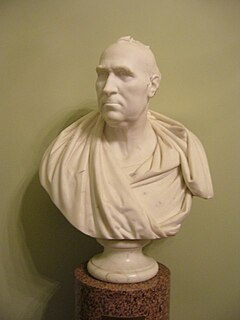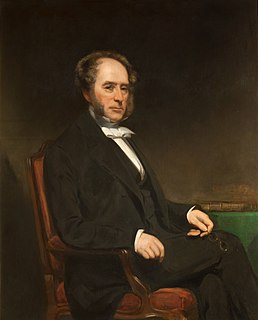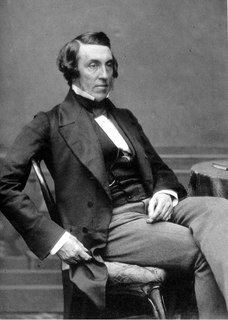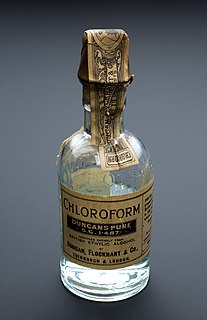
John Abercrombie was a Scottish physician, author, philosopher and philanthropist. His Edinburgh practice became one of the most successful medical practices in Scotland. The Chambers Biographical Dictionary says of him that after James Gregory's death, he was "recognized as the first consulting physician in Scotland". As surgeon to The Royal Public Dispensary and the New Town Dispensary he provided free medical care for the poor of the town and taught medical students and apprentices. He published extensively on medical topics and latterly on metaphysics morality and religion. A devout Christian he gave financial support to missionary work. Abercrombie was awarded the honorary degree of MD from the University of Oxford, was elected Rector of Marischal College and University, Aberdeen and appointed Physician to the King in Scotland.

William Pulteney AlisonFRSE FRCPE FSA was a Scottish physician, social reformer and philanthropist. He was a distinguished professor of medicine at the University of Edinburgh. He served as president of the Medico-Chirurgical Society of Edinburgh (1833), president of the Royal College of Physicians of Edinburgh (1836–38), and vice-president of the British Medical Association, convening its meeting in Edinburgh in 1858.

James Gregory FRSE FRCPE was a Scottish physician and classicist.

William Gregory FRCPE FRSE FCS was a Scottish physician and chemist. He studied under and translated some of the works of Justus von Liebig, the German chemist. Gregory also had interests in mesmerism and phrenology.

James BegbieFRSE FRCPE FRCSE was a Scottish medical doctor who served as president of the Medico-Chirurgical Society of Edinburgh (1850–2) and as president of the Royal College of Physicians of Edinburgh (1854–6).

The Canongate Kirkyard stands around Canongate Kirk on the Royal Mile in Edinburgh, Scotland. The churchyard was used for burials from the late 1680s until the mid-20th century.

Henry Cullen FRSE FRCPE (c.1758—1790) was a Scottish physician. He was chair and professor of medicine at the Royal Infirmary of Edinburgh. From 1776 until his death in 1790 he was a physician-in-ordinary to the Royal Infirmary of Edinburgh.

Andrew Duncan, the elder FRSE FRCPE FSA (Scot) was a British physician and professor at the University of Edinburgh. He was joint founder of the Royal Society of Edinburgh.
Andrew Duncan, the younger was a British physician and professor at the University of Edinburgh.

George Leith Roupell M.D. FRS (1797–1854) was an English physician.
Dr George Kellie MD, FRSE (1770–1829) was a Scottish surgeon who, together with Alexander Monro secundus gave his name to the Monro-Kellie doctrine, a concept which relates intracranial pressure to the volume of intracranial contents and is a basic tenet of our understanding of the neuropathology of raised intracranial pressure. The doctrine states that since the skull is incompressible, and the volume inside the skull is fixed then any increase in volume of one of the cranial constituents must be compensated by a decrease in volume of another. Previous research about George Kellie (1720–1779) may have been hampered by a widely cited incorrect year of birth, by the spelling of his name as Kellie or Kelly and by confusion with his father, also a surgeon in Leith, with the same name and subject to similar spelling variations.

Thomas Aitchison Latta was a medical pioneer who was responsible for the introduction of the saline solution methodology into the treatment of patients.
James Scarth Combe FRSE, FRCSEd (1796–1883) was a British surgeon. He was the first person to give an accurate description of pernicious anaemia and to recognise that atrophic gastritis was a feature of the condition. He was elected a Fellow of the Royal Society of Edinburgh in 1850 and served as President of the Royal College of Surgeons of Edinburgh in 1851–52.

Robert James Blair Cunynghame of Cronan, FRCSEd, FRSE JP was a prominent Scottish surgeon, physiologist and early forensic scientist in the late 19th century. He served as President of the Royal College of Surgeons of Edinburgh from 1891 to 1893. He is said to have had a calm beautiful face and his opinion was used as a benchmark to medical thought.
Dr Robert Daun FRSE FRCS was a prominent figure in 19th century Scotland with a colourful life, ranging from being with the Scots Greys at the Battle of Waterloo to being elected a Fellow of the Royal Society of Edinburgh.

Patrick Small Keir Newbigging FRSE FRSSA FRCSE (1813–1864) was a Scottish surgeon and general practitioner. He was President of the Royal Medical Society and of the Royal Scottish Society of Arts. Together with his father, Sir William Newbigging he formed one of the few father-son pairs of former Presidents of the Royal College of Surgeons of Edinburgh. His observations on the origin of the heart sounds and of the apex beat of the heart made a significant contribution to the debate.

James Duncan FRSE FRCS FRCSE was a Scottish surgeon and manufacturing chemist responsible for much of the British supply of chloroform in the mid-19th century. From 1839 to 1866 he was Director of Duncan Flockhart & Co one of Scotland’s largest chemical manufacturers.

James Hamilton FRSE FRCSE FRCPE (1767–1839) was a Scottish physician. He was a co-founder of the Lying-In Hospital in Edinburgh in 1791. He was president of the Royal College of Physicians of Edinburgh from 1812 to 1815. He was professor of medicine and midwifery at the University of Edinburgh from 1800 to 1839.
James Macadam Hare FRSE FRCS (1775–1831) was an eminent Scottish physician, closely linked to India, who was employed by the East India Company.

John Thomson FRS FRSE PRCPE (1765–1846) was a Scottish surgeon and physician, reputed in his time "the most learned physician in Scotland". He was President of the Royal College of Physicians of Edinburgh from 1834 to 1836.















